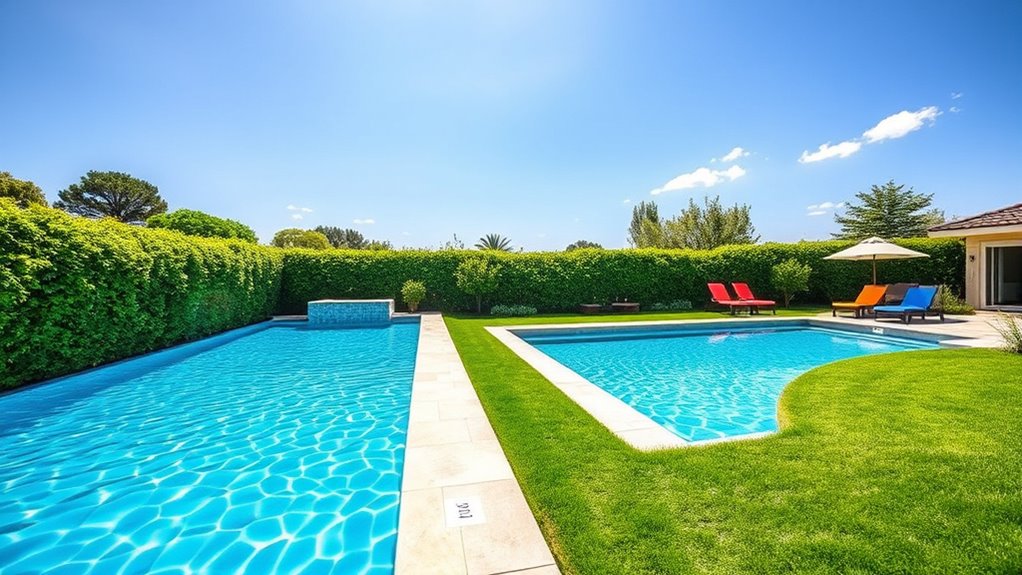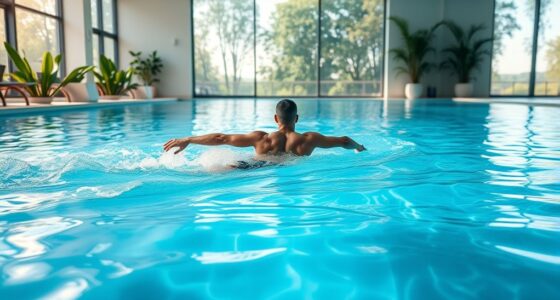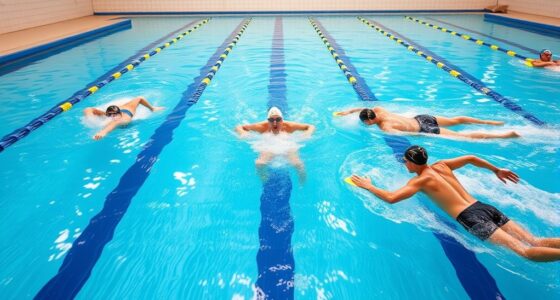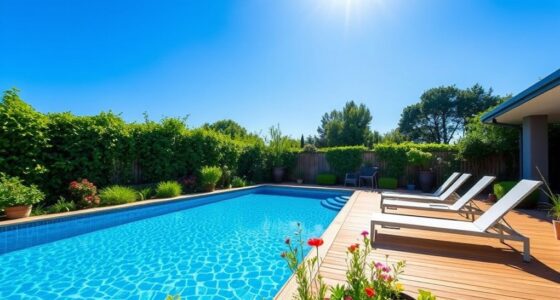If you want a low-maintenance pool primarily for exercise, a lap pool is a great choice since it’s smaller, easier to keep clean, and requires fewer chemicals. On the other hand, if you prefer a versatile space for relaxation, socializing, and family fun, a traditional pool offers more size and features but needs more upkeep. Your decision depends on whether you prioritize simplicity or multi-purpose use — explore more to see which fits your lifestyle best.
Key Takeaways
- Lap pools are smaller, easier to maintain, and require fewer chemicals, ideal for focused exercise and low maintenance.
- Traditional pools are larger and more versatile, suitable for relaxation, socializing, and family activities.
- Lap pools warm up quickly and maintain consistent water temperatures, perfect for dedicated exercise routines.
- Larger pools need more robust heating and filtration systems, increasing ongoing maintenance and costs.
- Choose a lap pool if you prioritize simplicity and exercise; opt for a traditional pool for versatility and leisure.
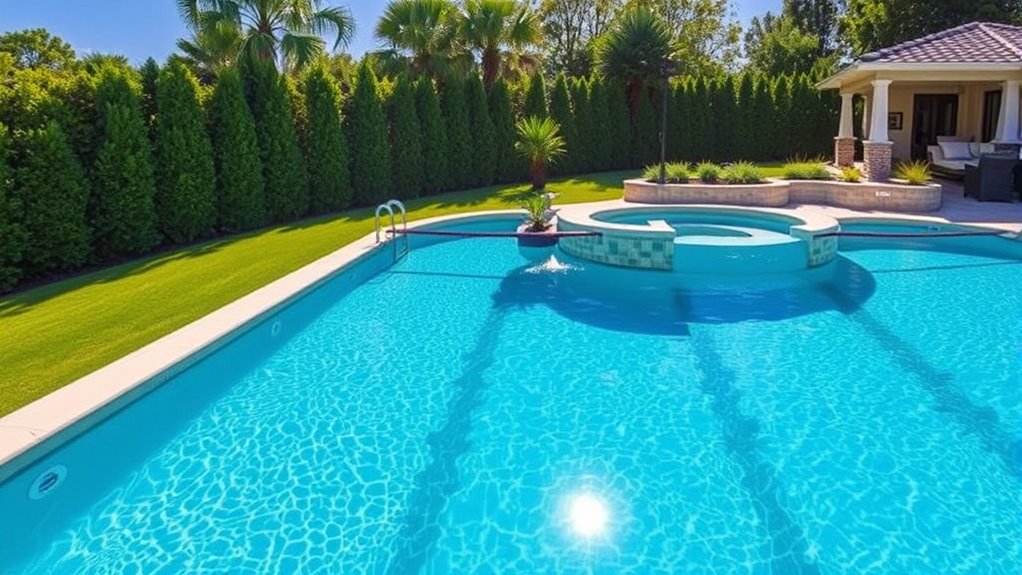
When choosing between a lap pool and a traditional pool, understanding their differences can help you make the right decision for your needs. One key aspect to consider is pool maintenance. Lap pools are typically smaller and more streamlined, which means less surface area to clean and fewer chemicals needed to keep the water clear. This can translate to easier upkeep and lower maintenance costs over time. Because of their size, they usually require less frequent filtering and chlorination, making it simpler to keep the water balanced. Proper water treatment becomes even more crucial in larger pools to prevent algae growth and ensure water clarity. Additionally, some lap pools incorporate specialized filtration systems that enhance water quality with minimal effort. Water temperature is another important factor. Lap pools are often designed with a focus on consistent, comfortable water temperatures ideal for exercise and endurance swimming. Because they’re smaller, they tend to warm up more quickly and maintain a steady temperature, which is great if you want to swim regularly without waiting for the water to heat up. Many lap pools also come with heating options to optimize water temperature for your workout routine. Traditional pools, however, may have larger volumes of water that take longer to heat and cool. If you enjoy swimming year-round, you might need to invest in more robust heating systems to keep the water at your preferred temperature. Additionally, larger pools are more susceptible to temperature fluctuations due to weather and outdoor conditions, which can make maintaining a consistent water temperature more challenging.
In essence, if you’re seeking a low-maintenance, temperature-controlled environment primarily for exercise, a lap pool may be the better choice. Its smaller size simplifies pool maintenance, and its design lends itself to stable water temperatures. Conversely, if you want a versatile space for relaxation, social gatherings, or family fun, a traditional pool offers more room and features but demands more effort to maintain and control the water temperature. Ultimately, your choice depends on your priorities: ease of maintenance and consistent water temperature point towards a lap pool, while versatility and size favor a traditional pool. Carefully weighing these factors will help you select a pool that best fits your lifestyle and swimming goals.
Frequently Asked Questions
How Much Does Maintenance Differ Between Lap and Traditional Pools?
Maintenance costs for lap pools and traditional pools mainly differ in pool cleaning and chemical management. Lap pools often require less cleaning due to smaller size and fewer surface areas, reducing time and effort. Chemical management can also be simpler, as smaller volumes of water need balancing. Traditional pools may need more frequent cleaning and precise chemical adjustments to keep the water clear and safe, leading to higher ongoing maintenance costs.
Can a Lap Pool Be Converted Into a Traditional Pool Later?
You wonder if a lap pool can become a traditional pool later. The good news is, pool conversion offers flexibility options, allowing you to adapt your pool to your changing needs. While transforming a lap pool into a traditional one involves some structural adjustments, it’s often possible with professional help. This flexibility means you can enjoy a dedicated workout space now and a relaxing pool later, customizing your backyard to suit your lifestyle.
What Are the Safety Considerations for Small or Shared Pools?
You need to prioritize safety in small or shared pools by monitoring pool depth to prevent accidents, especially for children or weak swimmers. Maintain proper water chemistry to avoid infections and skin irritations. Always supervise swimmers, use safety equipment like floatation devices, and ensure the pool area is secure. Regularly check that depth markings are visible and water quality is balanced, creating a safe environment for everyone enjoying the pool.
Which Pool Type Is More Energy-Efficient Over Time?
You’ll find that smaller or more efficient pools generally offer better energy savings over time, lowering your operational costs. If you choose a lap pool, it often uses less water and energy because of its size and dedicated purpose. Traditional pools may have higher energy demands due to larger volume and more features like waterfalls or heaters. Overall, investing in energy-efficient equipment and proper insulation helps maximize savings regardless of pool type.
Are There Zoning Restrictions for Installing Pools in Certain Areas?
Did you know over 50% of residential properties face zoning restrictions? You should check local zoning regulations before planning your pool, as they often specify setback distances, height limits, and pool types. Permit requirements vary by area, so contacting your city or county office guarantees you’re compliant. Ignoring these rules can lead to fines or having to remove your pool later, so always verify zoning rules before starting construction.
Conclusion
Choosing between a lap pool and a traditional pool depends on your fitness goals and lifestyle. Imagine Sarah, who installed a lap pool to focus on her swimming workouts after years of struggling with motivation. Now, she’s stronger, healthier, and more confident. Whether you want intense training or a relaxing family space, pick what fits your needs. A pool that aligns with your goals can transform your health and happiness—so make the choice that inspires you most.
